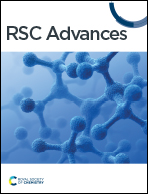Modification of sulfonated poly(arylene ether nitrile) proton exchange membranes by poly(ethylene-co-vinyl alcohol)†
Abstract
The modification of the physicochemical properties of sulfonated poly(arylene ether nitrile) (SPAEN) proton exchange membranes was demonstrated by poly(ethylene-co-vinyl alcohol) (EVOH) doping (named SPAEN-x%). By controlling the temperature during membrane preparation, the side reactions of the sulfonic acid groups to form sulfonic acid esters were effectively prevented, greatly reducing the proton conductivity of the membranes. Due to the flexible chain of EVOH, SPAEN-8% showed a relatively high elongation of 30.2%, which enhanced the aromatic polymers' flexibility. The SPAEN-2% membrane exhibited proton conductivity of 166, 55, and 9.6 mS cm−1 at 95%, 70%, and 50% relative humidity, respectively, higher than those of the other SPAEN-x% membranes and even comparable to that of Nafion 212. The water uptake, morphological study, and through-plane proton conductivity of the membranes were studied and discussed. The results suggest that EVOH doping can be used as an effective strategy to improve SPAEN-based proton exchange membranes' performance.



 Please wait while we load your content...
Please wait while we load your content...